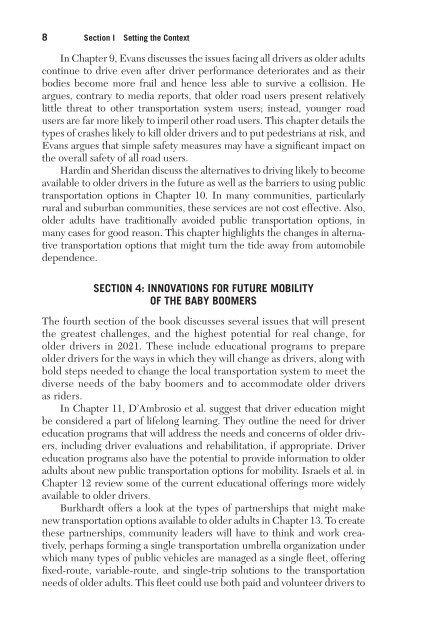Personal Choices and Public Policy - Springer Publishing
Personal Choices and Public Policy - Springer Publishing
Personal Choices and Public Policy - Springer Publishing
Create successful ePaper yourself
Turn your PDF publications into a flip-book with our unique Google optimized e-Paper software.
8 Section I Setting the Context<br />
In Chapter 9, Evans discusses the issues facing all drivers as older adults<br />
continue to drive even after driver performance deteriorates <strong>and</strong> as their<br />
bodies become more frail <strong>and</strong> hence less able to survive a collision. He<br />
argues, contrary to media reports, that older road users present relatively<br />
little threat to other transportation system users; instead, younger road<br />
users are far more likely to imperil other road users. This chapter details the<br />
types of crashes likely to kill older drivers <strong>and</strong> to put pedestrians at risk, <strong>and</strong><br />
Evans argues that simple safety measures may have a significant impact on<br />
the overall safety of all road users.<br />
Hardin <strong>and</strong> Sheridan discuss the alternatives to driving likely to become<br />
available to older drivers in the future as well as the barriers to using public<br />
transportation options in Chapter 10. In many communities, particularly<br />
rural <strong>and</strong> suburban communities, these services are not cost effective. Also,<br />
older adults have traditionally avoided public transportation options, in<br />
many cases for good reason. This chapter highlights the changes in alternative<br />
transportation options that might turn the tide away from automobile<br />
dependence.<br />
Section 4: Innovations for Future Mobility<br />
of the Baby Boomers<br />
The fourth section of the book discusses several issues that will present<br />
the greatest challenges, <strong>and</strong> the highest potential for real change, for<br />
older drivers in 2021. These include educational programs to prepare<br />
older drivers for the ways in which they will change as drivers, along with<br />
bold steps needed to change the local transportation system to meet the<br />
diverse needs of the baby boomers <strong>and</strong> to accommodate older drivers<br />
as riders.<br />
In Chapter 11, D’Ambrosio et al. suggest that driver education might<br />
be considered a part of lifelong learning. They outline the need for driver<br />
education programs that will address the needs <strong>and</strong> concerns of older drivers,<br />
including driver evaluations <strong>and</strong> rehabilitation, if appropriate. Driver<br />
education programs also have the potential to provide information to older<br />
adults about new public transportation options for mobility. Israels et al. in<br />
Chapter 12 review some of the current educational offerings more widely<br />
available to older drivers.<br />
Burkhardt offers a look at the types of partnerships that might make<br />
new transportation options available to older adults in Chapter 13. To create<br />
these partnerships, community leaders will have to think <strong>and</strong> work creatively,<br />
perhaps forming a single transportation umbrella organization under<br />
which many types of public vehicles are managed as a single fleet, offering<br />
fixed-route, variable-route, <strong>and</strong> single-trip solutions to the transportation<br />
needs of older adults. This fleet could use both paid <strong>and</strong> volunteer drivers to
















